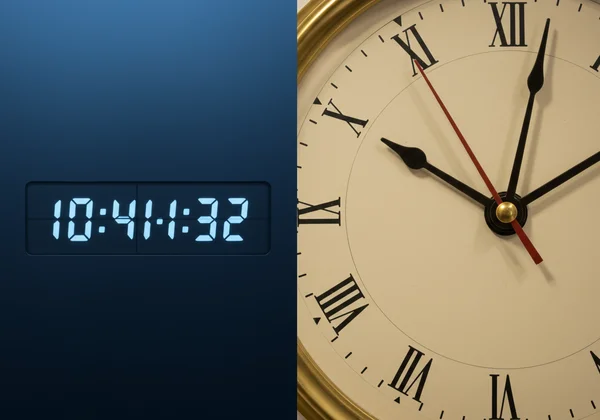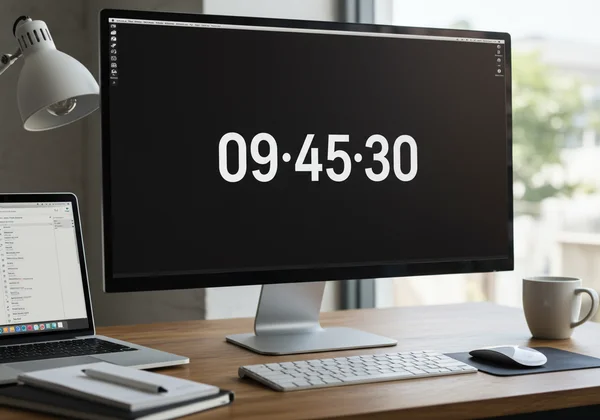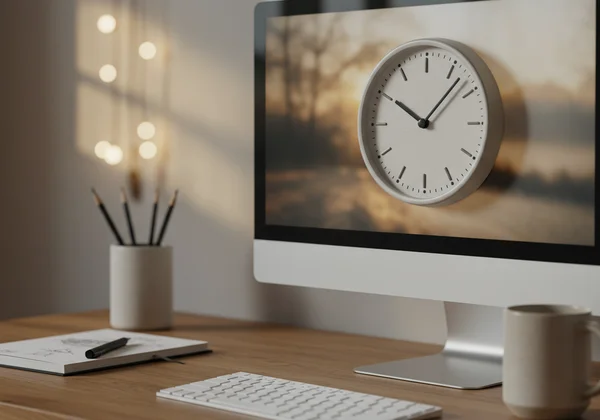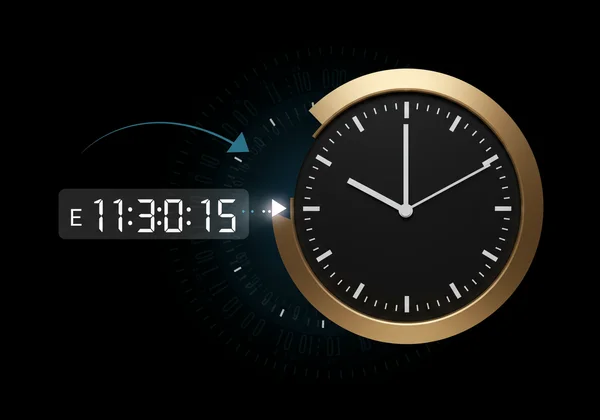Digital vs. Analog: Choosing Your Best Online Clock Display
In our hyper-connected world, time is a constant companion. We glance at it on our phones, our computers, and our walls. But in the debate of digital vs analog clock displays, have you ever paused to think about what you’re really choosing? This isn't just about numbers versus hands; it's about precision versus perception, data versus flow. What is the most accurate online clock display for your specific needs? The answer might surprise you, as it lies not in picking a side, but in having the power to choose both.
The way we see time dramatically influences how we manage it. A digital display gives us the cold, hard facts, while an analog face tells a story of the day's journey. Understanding the psychological impact of each can unlock new levels of productivity and mindfulness. This guide will explore the unique strengths of both formats and show you how a versatile [free online clock] can adapt to every moment of your day.

Understanding Digital Clock Advantages for Precision & Focus
The modern world often runs on deadlines measured in minutes and seconds. For tasks demanding absolute accuracy and quick information retrieval, the digital clock is an undisputed champion. Its primary strength lies in delivering unambiguous numerical data, which has profound effects on our cognitive processing and efficiency.
Instant Readability: Why Digital Clocks Excel in Numerical Clarity
When you need to know the time, you often need it now. The digital format presents time as a direct numeral—10:41:32. There is no interpretation required, no mental calculation of where the hands are pointing. This instant readability significantly reduces cognitive load, freeing up mental resources for the task at hand. For professionals like global project managers coordinating across time zones, or anyone in a fast-paced environment, this immediate clarity is invaluable.
This is why a digital display is the default for environments where every second counts, such as in broadcasting, competitive sports, or critical task management. It removes ambiguity and provides a definitive answer, allowing for faster, more confident decision-making. Using a clear, [realtime clock] ensures you are always synced perfectly with your schedule, down to the second.
Digital Clock Benefits for Productivity & Task Management
The directness of a digital clock lends itself perfectly to modern productivity techniques. When you're working in focused bursts, like the Pomodoro Technique, seeing the exact time remaining (e.g., 14:53) provides concrete feedback on your progress. It quantifies time, turning an abstract concept into a manageable resource. This numerical representation helps in segmenting your day into precise blocks for meetings, deep work, and breaks.
Furthermore, a digital clock fosters a mindset of precision. When you see the time laid out numerically, it encourages a more structured approach to planning. For students facing an exam or speakers managing a presentation, a large, fullscreen digital clock provides an anchor of control, clearly marking the passage of each minute and helping to pace activities effectively.

The Psychological Appeal: Exploring Analog Clock Benefits & Flow
While digital clocks offer precision, analog clocks provide something equally important: perspective. The circular face and moving hands tap into a more intuitive, spatial understanding of time. This traditional display does more than just tell time; it illustrates its continuous and cyclical nature, which has a unique psychological appeal.
Visualizing Time's Passage: The Analog Clock's Unique Perspective
An analog clock allows us to see time in relation to the whole. You don't just see that it's 2:45; you see that it's "a quarter to three." You can visually perceive the slice of the hour that has passed and the portion that remains. This visualizing time helps in gauging durations more naturally. For creative professionals, educators, or anyone engaged in long-form thinking, this perspective can feel less jarring and more conducive to a state of flow.
Professor Thompson, for instance, might use an [analog clock online] to teach his students about time management. Showing them a "45-minute block" on a clock face makes the concept of duration tangible in a way that numbers on a screen cannot. It helps us feel the rhythm of the day rather than just counting its seconds.
Aesthetic & Contextual Advantages of Analog Online Clocks
Beyond its functional benefits, the analog clock holds a timeless aesthetic appeal. Its classic design can bring a sense of calm, elegance, or even nostalgia to a digital workspace. For a designer like Leo, who curates every pixel of his environment, a beautifully rendered analog clock can be the centerpiece of a digital desktop, matching his theme and creating a more organic, less clinical atmosphere.
This aesthetic advantage isn't just about looks; it's about creating an environment that supports your mental state. A workspace designed with intention can reduce stress and improve focus. An analog clock can serve as a gentle, constant reminder of time's passage without the insistent, demanding nature of blinking digits, making it ideal for tasks that require patience and contemplation.

Digital vs Analog Clock: Making the Best Display Choice for You
So, which display is superior? The truth is, neither. The best clock is the one that best serves your current task, mindset, and environment. The real power lies not in choosing one over the other, but in having the flexibility to switch between them seamlessly. This is where a truly advanced timekeeping tool becomes essential.
Scenario-Based Selection: When to Choose Which View
Understanding the right tool for the job is key to optimizing your relationship with time. Here are a few scenarios to guide your choice:
- For High-Stakes Deadlines & Meetings: Choose Digital. When coordinating with a global team or timing a presentation, you need precise, unambiguous information. A large, clear [fullscreen digital clock] ensures everyone is on the same page.
- For Creative Work & Brainstorming: Choose Analog. To foster a state of flow and avoid the pressure of a minute-by-minute countdown, the spatial view of an analog clock is ideal. It helps you see blocks of time, encouraging deeper, less-interrupted thinking.
- For Teaching & Conceptualizing Time: Choose Analog. Explaining concepts like "half an hour" or "quarter past" is far more intuitive with a visual aid that shows these fractions of a circle.
- For Building an Aesthetic Workspace: Your choice! A sleek, minimalist digital display can look futuristic, while a classic analog face can add a touch of sophistication. The key is having a [customizable clock] that lets you control fonts, colors, and styles to match your vision.
Leveraging a Switchable Clock Display Feature
Why should you have to choose between two powerful tools? The core advantage of this versatile online clock is that you don't. With a single click, you can toggle between a hyper-accurate digital display and an elegant analog view. This switchable clock display feature puts you in complete control, allowing you to adapt your timekeeping tool to your needs in real-time.
Start your morning with a digital clock to plan your schedule with military precision. When you settle into a creative project, switch to the analog view to help you get into a state of flow. If you need to present, make it a large fullscreen digital display for clarity. This adaptability makes it the only online clock you'll ever need.

Optimize Your Focus & Flow with Versatile Timekeeping
The debate between digital and analog clocks is not about which is better, but about which is better for you, right now. Digital displays provide the raw data needed for precision and productivity, while analog displays offer the spatial perspective that fosters flow and deeper understanding. Each has a distinct psychological impact, and mastering both is the key to effective time management.
Ultimately, the most powerful tool is one that doesn't force a compromise. By providing an atomic-accurate, highly customizable, and instantly switchable clock, this platform empowers you to tailor your timekeeping to any task, mood, or environment. Stop choosing and start adapting. [Explore your options] today and discover a more intuitive and powerful way to interact with time.
Common Questions About Online Clock Displays
Can I easily switch my online digital clock to an analog view?
Absolutely. With our online digital clock, switching between digital and analog views is seamless. A dedicated button on the intuitive toolbar allows you to toggle between the two displays instantly, giving you the flexibility to choose the format that best suits your activity at any given moment.
How accurate is your online clock in both digital and analog modes?
Both the digital and analog displays are synchronized with atomic time servers, such as those maintained by the National Institute of Standards and Technology (NIST). This ensures you receive the highest level of precision available, regardless of which view you choose. You can trust that the time you see—whether in numbers or on a dial—is an [accurate clock] reading you can rely on for any critical task.
How do I customize my clock's appearance?
Customization is at the heart of the experience. The floating toolbar gives you complete control over your clock's aesthetics. You can easily change the font, text color, background color, and even switch between 12-hour and 24-hour formats. This allows you to design a clock that not only functions perfectly but also integrates beautifully with your digital workspace.